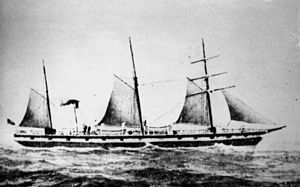SS Gothenburg

SS Gothenburg
|
|
| History | |
|---|---|
|
|
|
| Name: | Gothenburg |
| Namesake: | Gothenburg |
| Launched: | 1854 |
| Commissioned: | 1855 |
| Renamed: | RMS Celt, 1857 |
| Fate: | Sold, 1862 |
|
|
|
| Acquired: | 1862 |
| Out of service: | 1875 |
| Renamed: | SS Gothenburg, 1866 |
| Fate: | Wrecked, 24 February 1875. |
| Notes: | Rebuilt 1873 |
| General characteristics | |
| Tonnage: | 501 tons |
| Length: | 197 ft (60 m) |
| Propulsion: | Sails & propeller |
| Sail plan: | Barquentine |
| Complement: | 34 crew |
The SS Gothenburg was a steamship that operated along the British and then later the Australian and New Zealand coastlines. In February 1875, she left Darwin, Australia en route to Adelaide when she encountered a cyclone-strength storm off the north Queensland coast. The ship was wrecked on the Great Barrier Reef north-west of Holbourne Island on 24 February 1875. Survivors in one of the lifeboats were rescued two days later by Leichhardt, while the occupants of two other lifeboats that managed to reach Holbourne Island were rescued several days later. Twenty-two men survived, while between 98 and 112 others died, including a number of high-profile civil servants and dignitaries.
Gothenburg was commissioned in 1855 following her construction at Lungley's building yards in Millwall, London. She was a 501-ton, 197-foot-long (60 m) vessel, with a 120-horsepower (89 kW), coal-burning engine. She was rigged as barquentine, with her funnel set well aft between the main and mizzen masts. She was fitted with four lifeboats, two port and two starboard.
Her first owner, the North of Europe Steam Navigation Company, operated her between Irongate Wharf, near the Tower of London, and Sweden. In 1857, she was acquired by the Union Castle Line and renamed as RMS Celt. In June 1862, McMerkan, Blackwood and Co. of Melbourne purchased her for the Australian trade and in that year she made a protracted voyage from England to Australia by sail. She was one of the most modern vessels working around the Australian coastline in the 1860s, and became a popular ship as she was considered reliable. After many years on the Australia-New Zealand run, her owners transferred her to the Australian coastal service.
...
Wikipedia
